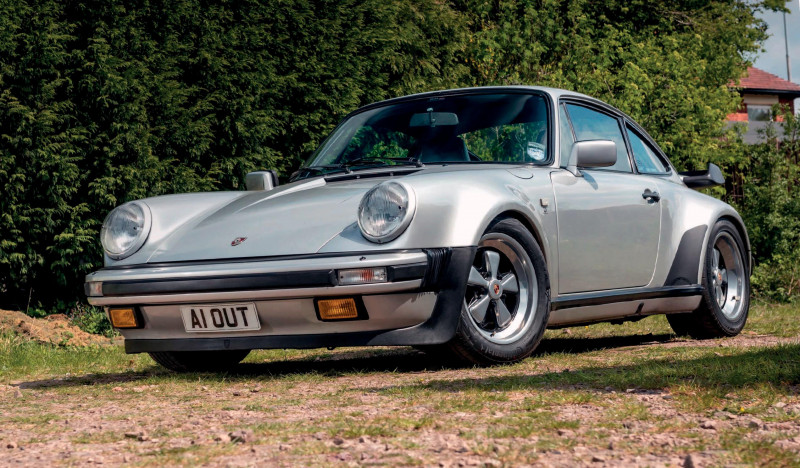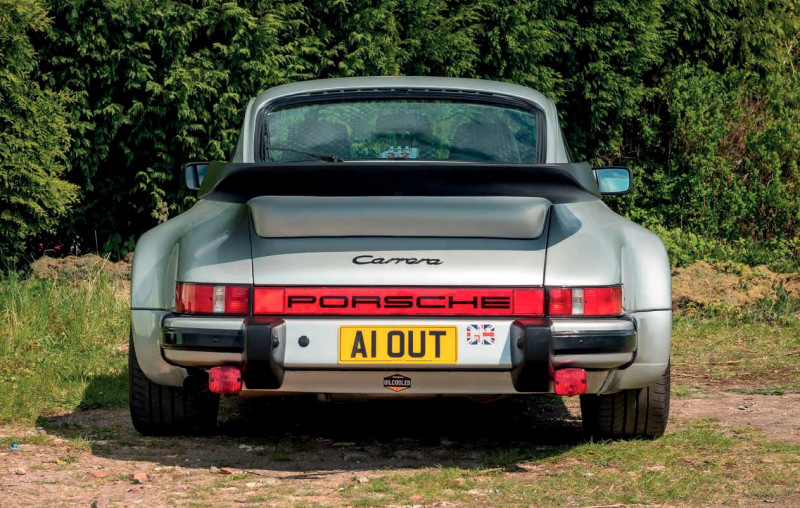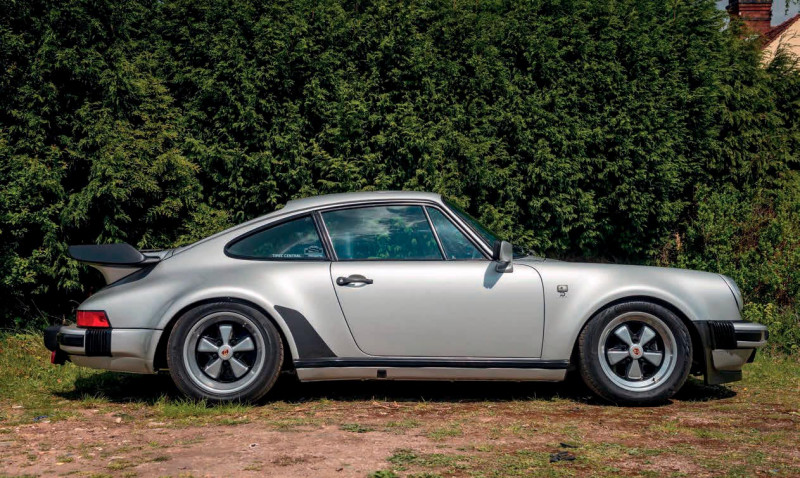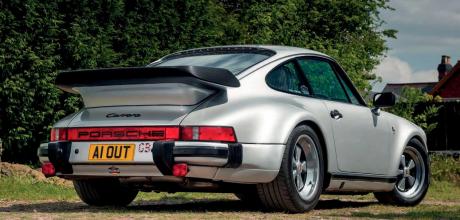1987 Porsche 911 Carrera 3.2 Supersport
Want the looks and handling of a classic 911 Turbo without massive lag and the threat ofleaving the road in corners? The 1987 Porsche 911 Carrera 3.2 Supersport could be just the Porsche for you...
Words Dan Furr
Photography Dan Sherwood
THE LOOK OF LOVE
The Carrera 3.2 Supersport

If you happen to be enjoying this magazine with a cup of coffee in hand, I suggest you put your drink to one side before continuing to read this paragraph — I fear you may experience hot brown stuff ejecting from your nostrils at warp speed by the time you get to the end of the next sentence. Not everybody wants to own a 911 Turbo. There, I said it. It’s out there. Sure, we all love the aggressive, wide-hipped 930’s looks, and there’s absolutely no denying it’s a bucket list car for many Porschephiles, but the truth of the matter is the forced-fed classic 911 is too boisterous for the majority of drivers who simply want to enjoy a ride out in an air-cooled Porsche, ideally without ending up in a hedge when putting their foot to the floor. Well, we are talking about the ‘Widowmaker’, after all.

That said, just because a punch in the back after a couple of seconds of apparent engine inaction doesn’t necessarily appeal to you, none of this means you don’t want a 911 exhibiting the same mean aesthetic as a 930. Perhaps a narrow body is too tame for your tastes?
WITH THE PRICE OF OWNERSHIP CURRENTLY HOVERING AROUND £90k, TURBO LOOKS CARRY A FINANCIAL COMMITMENT

It’s a sentiment I can appreciate — among Furr’s Fleet resides a first-generation 997 Carrera 4S. This late 2006 build shares the wide rear end and muscular haunches of the same-age 997 Turbo, but the flat-six powering my car is a 3.8-litre normally aspirated unit developing 350bhp and 295lb-ft torque. Compare this with the 997 Turbo’s thundering 473bhp and 457lb-ft, rising to 502lbft on overboost. On paper, the twin-turbocharged 911 is a dream machine easily outgunning my Carrera 4S, but in reality, on UK roads at least, the Carrera 4S is, in my opinion, a far better proposition. Put it this way, on the public highway, the majority of drivers are far more likely to explore the full range of the Carrera 4S’s capabilities than they are those of the Turbo, which will rarely get driven anywhere close to its potential by all but the most experienced of 911 drivers and trackday enthusiasts. Put simply, on the road, you’re unlikely to find the Turbo’s limit, but it will certainly find yours.
LACK OF POWER STEERING AND HAVING TO PUSH THE BRAKE PEDAL WITH FORCE TO ACHIEVE BITE

BEST IMITATION
Where my 997 Carrera 4S’s vast rump echoes that of the same-generation Turbo, the earlier 996 Carrera 4S (arguably the best-value 911 money can buy right now) took things a step further, inheriting the 996 Turbo’s wheels, side skirts and vented bumpers, alongside its fatter dimensions. In fact, save for the absence of the Turbo’s rear-quarter-situated intakes and its engine lid adornment, there’s very little to visually separate these two 996s. The gap becomes even more blurred with the 992, which eliminates the narrow body altogether, ushering in “generously proportioned” shells across the entire 911 range.
Clearly, even if the edge-of-your-seat driving experience delivered by a 911 Turbo doesn’t appeal to everyone, there’s huge appetite for Turbo looks among Porsche owners, irrespective of their 911’s mechanical make-up. It’s something Porsche was aware of as far back as the mid-1980s, when the manufacturer’s Sundwerwunsch (Special Wishes) department released the Turbo-look Carrera 3.2 coupe into the wild. A Targa variant followed and, by 1985, these intriguing offerings — complete with the contemporary 930’s bodywork, wide wheels, rear spoiler, brakes and suspension — became regular models, initially known in the UK as ‘Carrera with Sport Equipment’. In advanced of the 1987 model year, the Turbo-look Carrera 3.2 was relabelled ‘Carrera Supersport’. Thanks to the non-availability of the 930 in the USA from 1984 through 1986 (due to strict Stateside emissions regulations), the wide-hipped, big-tailed Supersport was particularly popular in the land of Uncle Sam, becoming an unmistakable 1980s cultural icon. A separate Sport pack comprising a reduced equipment list was offered in the UK under the ‘911 with Sport Equipment’ banner.
The silver machine on these article is a Carrera 3.2 Supersport built for the 1987 model year. Only a handful of right-hand drive examples were supplied to the UK. This particular example holds the distinction of being the very last equipped with a 915 gearbox. “It was an order away from being loaded with a Getrag G50!” laughs owner, Lindsay Brown, one of The Independent Porsche Enthusiast Club (TIPEC)’s regional officers. He’s owned the car for twelve years and ‘traded up’ from a 944 S. “I loved the 944, but I couldn’t escape the want for a 911. I spotted this car featured in the dealer showcase pages of 911 & Porsche World magazine and knew I’d found ‘the one’.” The glowing five-star review filled him with encouragement. “Without much in the way of delay, I contacted the seller and arranged a test drive.”
For many, the idea of owning a classic 911 — or any retro ride, for that matter — is as much about the romantic notion of being in charge of a car like this, as it is the promise of a thrilling driving experience free of the trappings (read: driver aids) of modern motoring. Did the Turbo-bodied Supersport live up to expectation? “Not exactly,” Lindsay grins. “I’d loved the six years I’d spent driving the 944, which was a standard 2.5-litre S, save for Cup sixteeninch wheels. I probably wouldn’t have sold it if I’d had sheltered storage to take advantage of. The 911, though, was completely free of rust and boasted excellent specification, including a sunroof, Sport seats and air-conditioning, along with the Turbo body.
I was holding out for a Guards Red Carrera 3.2 with black leather, but this silver Supersport was too good to miss out on. In no way, however, did I anticipate not enjoying my time behind the wheel.” Along with Lindsay’s request for a 50mm drop in ride height, a dink in the front valance was sorted before he welcomed the car to his home in Tamworth. Immaculate and riding on Fuchs finished in black, the sparking silver tin-top looked every bit as menacing as a full-fat Turbo. What, then, was the problem? “I just couldn’t gel with it,” he sighs. “In fact, I was considering selling up and going back to a front-engined, water-cooled, four-cylinder Porsche. The 944 was an effortless drive with near equal front-to-rear weight distribution. It handled brilliantly and its hatchback made for a very practical Porsche. I began to wonder if I’d be better suited to a 968 than an air-cooled 911.”
Chief among his complaints were the Supersport’s lack of power steering and having to push the brake pedal with force to achieve bite, preventing him from driving the 911 as hard — and with as much confidence — as he’d pushed the 944. Looking back, however, he recognises the fault lay with not getting enough time to really familiarise himself with the quirks and character of the air-cooled Porsche. “I decided to take it on a trip to Le Mans and back. Concentrated seat time driving this 911 over long distance provided me with the opportunity to really get to know the car and work out how to get the best from it. You could say we returned from Le Mans as a happy couple!”
Obviously, it’s a lasting love, so what advice does he offer prospective Supersport purchasers reading this article? “If, like me, you cover many miles in modern cars in regular driving conditions, it’s important to remember the Carrera 3.2 is a comparatively basic car, even though you can take advantage of electric windows and power seats. You really need to drive the thing. Take it by the scruff of the neck, else it will bite back. And take it from me, the more time you spend driving a 911 like this, the more you’ll discover its true potential, encouraging confidence in your driving and resulting in more enjoyable journeys.”
SYMBOL SHIFT
His Supersport’s typically notchy 915 gearbox was soon discovered to need an overhaul, necessitating the installation of new synchros and dogteeth (“it was crunching in and out of first and second”). Later, after the engine began ‘sweating horsepower’ by way of oil mist in the engine bay, Paul and Mike Chare, owners of Worcestershire-based independent Porsche specialist, Zuffenhaus, were called upon to carry out a top end engine rebuild. “They did an excellent job,” Lindsay confirms. “The car was using a litre of oil every five hundred miles, but since Zuffenaus worked their magic, it hasn’t lost a drop between service intervals.”
The ‘leaves’ of the black Fuchs were painted silver, a strut brace was added and chassis tuning was carried out by Pete Leason and Chris Franklin at Center Gravity, giving the car more responsive handling, complemented by sticky Continental rubber. “The rears feature a 245/45/16 profile, which is becoming increasingly difficult to get hold of. Choice is very limited,” Lindsay warns. Indeed, a glance at blackcircles.com illustrates only four options (Nankang, Yokohama, Pirelli and Michelin), where once there were many more to choose from, including the Contis his Porsche currently wears. He also suggests Turbo body panels are proving to be in short supply right now, though has no plans to put his car in a position where it might need them! “On the plus side,” he continues, “independent Porsche parts retailers, such as Design 911, stock lots of spares for the Carrera 3.2 and 930, meaning would-be owners shouldn’t have any trouble getting hold of most other repair and maintenance items.”
At its original point of sale, a Supersport (option M491, as indicated on the VIN/options sticker fixed to a genuine example’s inside front lid) commanded close to ten grand more than a standard Carrera 3.2. Today, you can expect to pay a twenty grand premium. “You’re obviously getting a raft of 930 equipment, even though the engine remains a 3.2-litre normally aspirated flat-six producing 230bhp,” Linsday stresses, “but this is a largely unburstable engine and provides satisfying levels of torque low down the rev range. The Carrera 3.2 isn’t as quick as the 944 point to point, but it’s much more fun, requiring you drive harder to cover ground at the same rate.”
He goes on to highlight out how the 944 is far cheaper to buy, run, insure and maintain than a Carrera 3.2, let alone a Supersport, but the reward for buying the 911 is a more engaging Porsche. Moreover, he says it’s a car others seem to appreciate just as much as whoever is in the hot seat. “At the lights, other road users would want to race the 944, revving their engines as a signal of intent. In contrast, when I’m driving the 911, people smile, wave, wind their windows down and tell me how much they like the car.” I admit, comparing a 944 S and a Carrera Supersport is a tad like pitching apples and oranges against one another, but when so many marque enthusiasts view the 944 as the ‘gateway’ Porsche to an air-cooled 911, it’s worth hearing from someone who has ownership experience of both cars. “They’re very different Porsches offering very different driving experiences,” Lindsay advises. “The 944 is, in many respects, a far more comfortable Porsche, certainly in right-hand drive guise, where your legs are straight on the pedals, unlike the 911, where they’re to one side. The best advice I can give is for people try both and see which suits them best, keeping in mind the 911’s true performance potential might take time for a new owner to fully appreciate,” he adds, knowingly.
The keen-eyed show-goers among you might recognise this Turbo-bodied beauty from its star turn at the Lancaster Insurance Classic Motor Show, where it lined up alongside a 944, 996 Turbo and a Chesil 356 Speedster — all dressed in silver — on the TIPEC stand to mark the club’s twenty-fifth anniversary. Lindsay uses his Supersport most weekends (“I’m not afraid to drive it”) and has followed his decisive Le Mans trip with TIPEC outings to visit classic car shows all over France, as well as various breakfast meets across the UK.
With the price of Supersport ownership currently hovering around the £90,000 mark, Turbo looks certainly carry a financial commitment from buyers, but where the yet-more-expensive 930 delivers a drive in most cases unlikely to be fully appreciated (thanks to limitations of the majority of weekend drivers’ capabilities behind the wheel, questionably maintained roads and a sharp increase in the amount of traffic in recent years), the Supersport’s normally aspirated 3.2-litre beating heart works brilliantly to provide a linear delivery of power capable of being brought under control far easier by most drivers, thereby allowing them to become more engaged with the 911 they’re in charge of.
One might go a step further by arguing how a combination of the Turbo’s chassis equipment, styling and the Carrera 3.2 powertrain does, in fact, make the Supersport the most usable of all 911s produced in the decade of red braces and filofaxes.
1989 marked the end of the G-series 911, but Porsche continued to develop the Carrera 3.2 until the bitter end. The Speedster variant (option M503) borrows its inspiration, name and style from the similarly styled 356 Speedster, as featured elsewhere in DrivesToday.
Essentially a low-roof version of the Cabriolet, the Carrera 3.2 Speedster features a cut-down windscreen and a pair of body-coloured polyurethane ‘humps’ covering an unlined, manually operated hood. Buyers could choose narrow-body or Turbo-look versions, each benefiting from a model-specific front valance.
The Carrera 3.2 cemented the 911’s reputation for quality of build and reliability. Today, it offers lucky owners performance and panache with few drawbacks. Add the Turbo body, brakes and suspension, and you’ve got the best normally aspirated 911 from the 1980s. Supersport — who needs a turbocharger anyway?!
Above All the Turbo looks and chassis kit, but in a more user-friendly Carrera 3.2 performance package. Above An owner’s choice of tyres for the rear are becoming increasingly narrow Below Top-end rebuild was carried out by Zuffenhaus. Above Is the Carrera 3.2 Supersport the most usable 911 to roll out of the 1980s?
Above Air-conditioning was a rarely optioned extra, but Linsday’s car includes the system, as well as sunroof Below It’s not the black interior Lindsay was hoping to be sat in, but the silver paintwork and oh-so-blue cabin work well together.
Above Officially known as the M491 option and initially available for an extra DM25,590 through Porsche’s Sonderwunsch (Special Wishes) department, the Carrera 3.2 Supersport gained Turbo-aping wide wheel arches, a ‘whale tail’ wing, a wraparound front spoiler, the 930’s stiffer suspension, its superior braking system and wider wheels.


